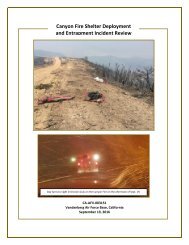Final Report to the Joint Fire Science Program
13-1-04-45_final_report
13-1-04-45_final_report
You also want an ePaper? Increase the reach of your titles
YUMPU automatically turns print PDFs into web optimized ePapers that Google loves.
Coop & Magee P-J Fuel Treatment Effects 12/31/2016<br />
treatments at <strong>the</strong> landscape scale including <strong>the</strong> Piñon Jay and Mountain Bluebird (Sialia<br />
currucoides).<br />
At <strong>the</strong> local spatial scale, 4 species showed significant negative treatment effects, and 4 species<br />
responded positively <strong>to</strong> local scale habitat changes. The Black-headed Grosbeak (Pheucticus<br />
melanocephalus) and Broad-tailed Hummingbird (Selasphorus platycercus; generalists), <strong>the</strong> Ashthroated<br />
Flycatcher (Myiarchus cinerascens; open conifer woodlands), and <strong>the</strong> Piñon Jay had<br />
greater occupancy in <strong>the</strong> control sites compared <strong>to</strong> treatments. The Lark Sparrow (Chondestes<br />
grammacus; edge species) occupied 20% of control sites at <strong>the</strong> local scale compared <strong>to</strong> 11% of<br />
hand thinned sites and 62% of mastication sites. The American Robin (Turdus migra<strong>to</strong>rius) and<br />
Western Bluebird (Sialia Mexicana; open conifer woodlands), and Blue-gray Gnatcatcher<br />
(Polioptila caerulea; shrublands/woodlands) also had elevated local occupancy in treatments.<br />
One species’ occupancy responses were mixed at landscape and local scales. Piñon Jay<br />
occupancy increased in response <strong>to</strong> landscape scale treatments, but decreased at <strong>the</strong> local scale.<br />
Two species showed mixed responses <strong>to</strong> mastication and hand-thinning treatments: <strong>the</strong> Ashthroated<br />
Flycatcher (Myiarchus cinerascens) responded negatively <strong>to</strong> hand-thinning and neutrally<br />
<strong>to</strong> mastication, and <strong>the</strong> Mountain Bluebird responded negatively <strong>to</strong> hand-thinning but positively<br />
<strong>to</strong> mastication.<br />
Treatment Effects on Vegetation and Fuels<br />
Treatments drove major, persistent shifts in forest structure and composition, and canopy and<br />
surface fuels, relative <strong>to</strong> controls. Tree cover and canopy fuels were strongly reduced;<br />
concomitantly, down woody surface fuels (1- and 10-hour fuels) and live herbaceous fuels were<br />
elevated. Live woody (shrubby) surface fuels were not significantly different between controls<br />
and treatments, but increased significantly as a function of time-since-treatment, indicating<br />
increasing importance over time. Not only was <strong>the</strong> density and basal area of piñon and juniper<br />
strongly reduced in treatments, but it did not show any recovery with time-since-treatment.<br />
Likewise, seedling density was lower in treatments than controls, and did not show any increase<br />
over time, indicating that treatment effects will be persistent over many decades.<br />
Across all samples, we identified 20 exotic species classified as introduced (USDA, NRCS<br />
2015), including: crested wheatgrass (Agropyron cristatum), burdock (Arctium minus),<br />
cheatgrass (Bromus tec<strong>to</strong>rum), littlepod false flax (Camelina microcarpa), musk thistle (Carduus<br />
nutans), Canada thistle (Cirsium arvense), bull thistle (Cirsium vulgare), bindweed (Convolvulus<br />
arvensis), s<strong>to</strong>rk’s bill (Erodium cicutarium), prickly lettuce (Lactuca serriola), black medic<br />
(Medicago lupulina), alfalfa (Medicago sativa), yellow sweetclover (Melilotus officinalis),<br />
prickly Russian thistle (Salsola tragus), tall tumblemustard (Sisymbrium altissimum), salsify<br />
(Tragopogon dubius), puncturevine (Tribulus terrestris), white clover (Trifolium repens),<br />
mullein (Verbascum thapsus), and hairy vetch (Vicia villosa). Exotic species were much more<br />
frequently encountered at treated than control sites, occurring at 86% of sample plots in<br />
treatments and 51% of untreated sample plots (Wilcoxon signed rank test P < 0.001, 23 d.f.;<br />
Figure 2a). Richness of exotic species in treatments was more than double that of controls: 2.8<br />
species in treatments, 1.3 species in controls (paired t-test P < 0.001, 23 d.f.; Figure 2b). Total<br />
8




